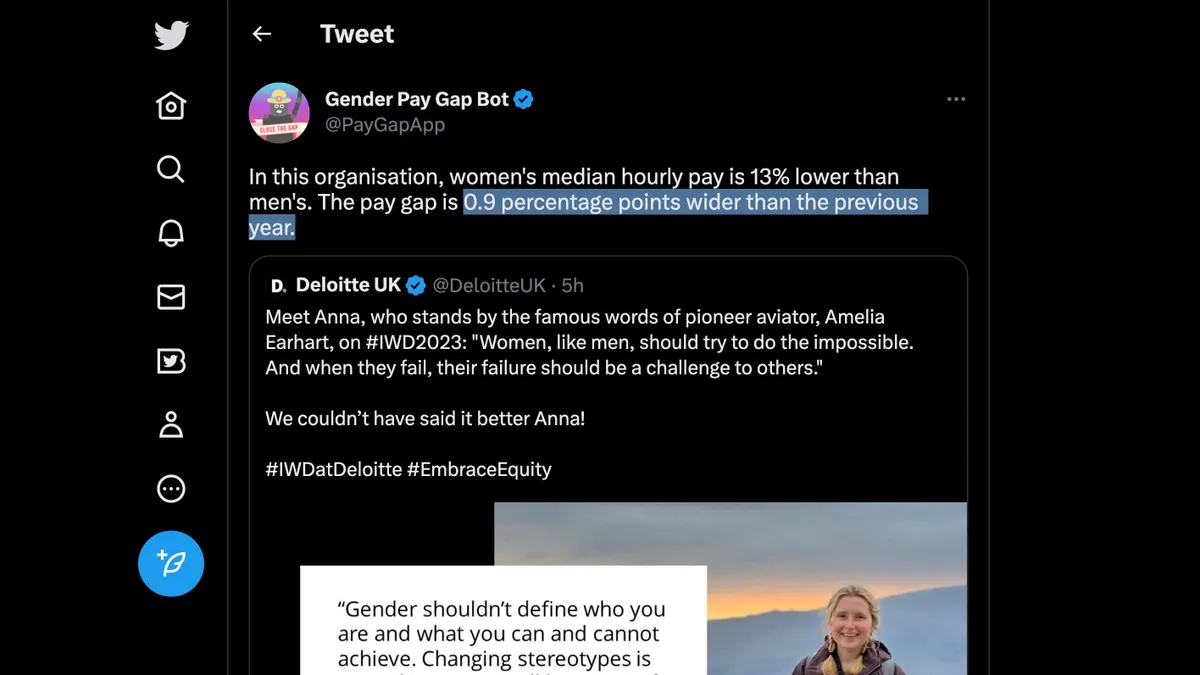If M3gan, ChatGPT and Microsoft Bing’s AI aren’t plaguing British managers’ nightmares, at least one robot rises to the occasion. The Gender Pay Gap App (@PayGapApp) is a Twitter bot that quote-tweets companies’ cheery and effusive International Women’s Day posts with the gender pay gap present at that company.
The bot has existed since 2021, but copywriter and freelance social media manager Francesca Lawson told HR Dive she considered that a trial year. She and co-creator Ali Fensome, a software engineer, brought their bot to life out of frustration, Lawson said over video chat.
“One day a year, companies really go for it and pledge their support for women — and for gender equality, more generally — but don't do enough, the rest of the year,” she observed. She felt like brands kept “talking down to women” and she almost felt powerless to change it.
“It was cobbled together over the space of a weekend. We didn’t know if it was going to work. We didn’t know whether … anyone was going to be interested. It was just a bit of an experiment to see if we could get this data to present at the right moment,” Lawson explained. It gained some attention two years ago, with buzz really building in 2022. Today, it has more than 230,000 followers. As HR Dive spoke with Lawson a few days before IWD, she said it was gaining about 100 followers an hour.
Just as English companies have come online early with IWD posts, the bot has been at the ready with its pay data — causing eruptions of joy in its mentions as well as leading some companies to switch up their account privacy settings in the wake of the robot’s heat. Some employers even delete their tweets.
In this organisation, women's median hourly pay is 16.7% lower than men's. https://t.co/jCwSii9oGf
— Gender Pay Gap Bot (@PayGapApp) March 7, 2023
In this organisation, women's median hourly pay is 7.7% lower than men's. The pay gap is 4.3 percentage points smaller than the previous year. https://t.co/fZSta3ZtMt
— Gender Pay Gap Bot (@PayGapApp) March 7, 2023
Between last International Women’s Day and today, a lot more has transpired. Some companies responded to the pay gap bot; some were defensive, while others took accountability for their lack of pay equity (mentioned, for example, was Imperial College of London).
The application also got a makeover: Now, rather than just providing the current gender pay gap, the bot also reports whether the status has changed since the prior year. Some companies have whittled their gap down. Others have widened.
In this organisation, women's median hourly pay is 13% lower than men's. The pay gap is 0.9 percentage points wider than the previous year. https://t.co/Wx1ed3WA6r
— Gender Pay Gap Bot (@PayGapApp) March 7, 2023
“If a company has a big pay gap but they can show that they've reduced it by 10% over the past year, then that's something that’s actually worth acknowledging,” Lawson said. She wouldn’t go as far as to use the word “celebrate,” she noted, adding that it makes employers “look much less bad than when we’re calling out their performative activism.”
In this organisation, women's median hourly pay is 3.9% lower than men's. The pay gap is 9 percentage points smaller than the previous year. https://t.co/SXP7w0RmAK
— Gender Pay Gap Bot (@PayGapApp) March 7, 2023
In this organisation, women's median hourly pay is 17.4% lower than men's. The pay gap is 9.4 percentage points wider than the previous year. https://t.co/vga1kaSbAY
— Gender Pay Gap Bot (@PayGapApp) March 7, 2023
As March 8 rolls around, Lawson expressed hopes that some companies change the tone of their messaging. She doesn’t want employers to stop acknowledging IWD — she just wants them to be more intentional in addressing gender equity issues.
That’s where the data comes in. Lawson describes it as a tool to help “refocus the narrative” around women’s issues on IWD, instead of “pushing out one very nicely illustrated graphic with a script font and utterly meaningless quotes.”
The creative strategist pulled out a pocket-sized book, its cover awash in purple and pink watercolor motifs and the slogan, “Go, girl!” She holds it up, explaining that she received it when she left a job.
“I keep getting tempted to put it in the bin or give it to the charity shop. But I actually kind of like keeping it around, to keep me angry and keep me reminded of the absolutely useless things to avoid saying,” Lawson said. It’s an entire book of the kind of platitudes companies will share for IWD, she said.
“‘You are valued. You’re a goddess and don’t forget that,’” she read. She continued with a quote about climbing up the top of the corporate ladder.
“If you really value women, then that’s got to come through in policies. That’s got to come through in actions — not just wanting to come across as ‘really inclusive’ and ‘really fair,’” she said, bringing up diverse hiring, promotion cycles and parental leave as gender equity issues as well.
In this organisation, women's median hourly pay is 65.1% lower than men's. The pay gap is 38.2 percentage points wider than the previous year. https://t.co/YZ5GQKeBz7
— Gender Pay Gap Bot (@PayGapApp) March 7, 2023
The issues across the pond mirror issues in the U.S. Pay gap data is collected by the U.S. Census Bureau (although its scope is limited to full-time talent). The most recent data indicates that year-round, full-time working women earn 82% of what year-round, full-time working men earn. In 2002, Pew Research Center analysis shows, women earned 80% of men’s earnings. The data suggests that the U.S.’s gendered wage gap has been consistent for the last 20 years.
Still, the American legal landscape around transparency largely differs from that of the U.K. Salary history bans are slowly trickling in stateside as diversity, equity and inclusion experts continue to tell HR Dive that pay transparency is one DEI hot topics of 2023.
One of the largest talent markets, New York City, just started posting salary ranges. Even then, many employers were following the letter of the law as opposed to the spirit of the law, listing the kind of absurd salary ranges that would make budgeting impossible.
Meanwhile, since 2017, companies in England, Scotland and Wales employing 250 people or more workers have been legally required to report their gendered wage gap — both on their website and through a U.K. government portal.
Still, just because there’s transparency doesn’t mean there’s accountability. “There's no legislative requirement for the companies to act on that data and make things right,” Lawson said.
In this organisation, women's median hourly pay is 0.3% higher than men's. In the previous year, women's median hourly pay was 2.3% lower than men's. https://t.co/dI0YZod02H
— Gender Pay Gap Bot (@PayGapApp) March 7, 2023
Regardless of national government, HR professionals will have to deal with the talent repercussions of performative allyship — whether it’s a wage gap or some other kind of discriminatory systemic issue plaguing their workplace.
“It's going to lead to disappointment,” Lawson said. She painted a picture of a candidate taking a job offer based on that company’s public commitment to DEI. But what if it’s just a commitment, without action?
“A few weeks a few months down the line, maybe they've experienced some sexist behavior. Maybe they're getting talked over in meetings. Maybe they've been trying to get ideas implemented, but you know, people keep dismissing them,” she said. “You just end up losing a whole load of opportunity because you wear people out.”





















